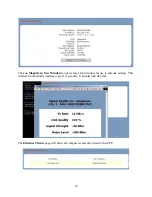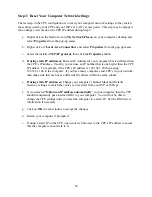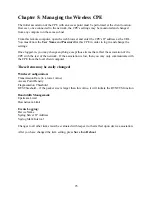
11
Chapter 3: Installing the Wireless CPE
Selecting a Mounting Location
It is very important to position the CPE to ensure the highest possible data transfer speed in all
kinds of weather and in all seasons. The wireless CPE operates on a radio frequency of 2.4 GHz
and must be line-of-sight (LOS) with the access point (AP) or other CPE if in Ad-Hoc mode.
Hills, buildings, trees and large vehicles must not block the signal path. Trees are especially
troublesome as they may allow the signal to pass easily in winter when leaves are off, but may
block the signal in the other seasons. Check the FAQ’s under “Pre-Installation and Site
Preparation” or “Radio Propagation” or “Troubleshooting” on the Telex Wireless web pages for
helpful hints. (
http://www.telex.com/Wireless/faq.nsf/c
)
Determine the exact location of the nearest Access Points (AP’s) in your system. Choose a
location on the roof, mast, wall or fascia for your wireless CPE so that the CPE has a clear shot
to your AP. The closest AP may not necessarily have the best path if it is blocked by hills,
buildings or trees.
Ensure that the chosen signal path has sufficient Fresnel zone clearance with respect to the
ground or other obstacles near the path. Check the Telex FAQ’s under “Radio Propagation” for
more information on Fresnel zone clearance.
Ensure that your mounting location is less than 100 meters from the computer, hub, switch or
router location. (Maximum length of CAT-5 cable is 100 meters) Determine the building entry
point ahead of time to prevent problems later.
Limit the exposure of the CPE to wind if possible. Mounting the CPE on the fascia (under the
eaves) is best if the signal path is not blocked in this location.
Attaching the Mounting Bracket and Aiming
First, determine the polarization of the wireless CPE. If the Access Point uses vertical
polarization (V-pol), then the CPE must be installed vertically polarized. If the AP is H-pol, then
the CPE must be installed horizontally polarized. The arrow on the CPE label points vertically
when it is V-pol, and horizontally when H-pol. The arrow direction also corresponds with the
long dimension of the CPE radome.












































